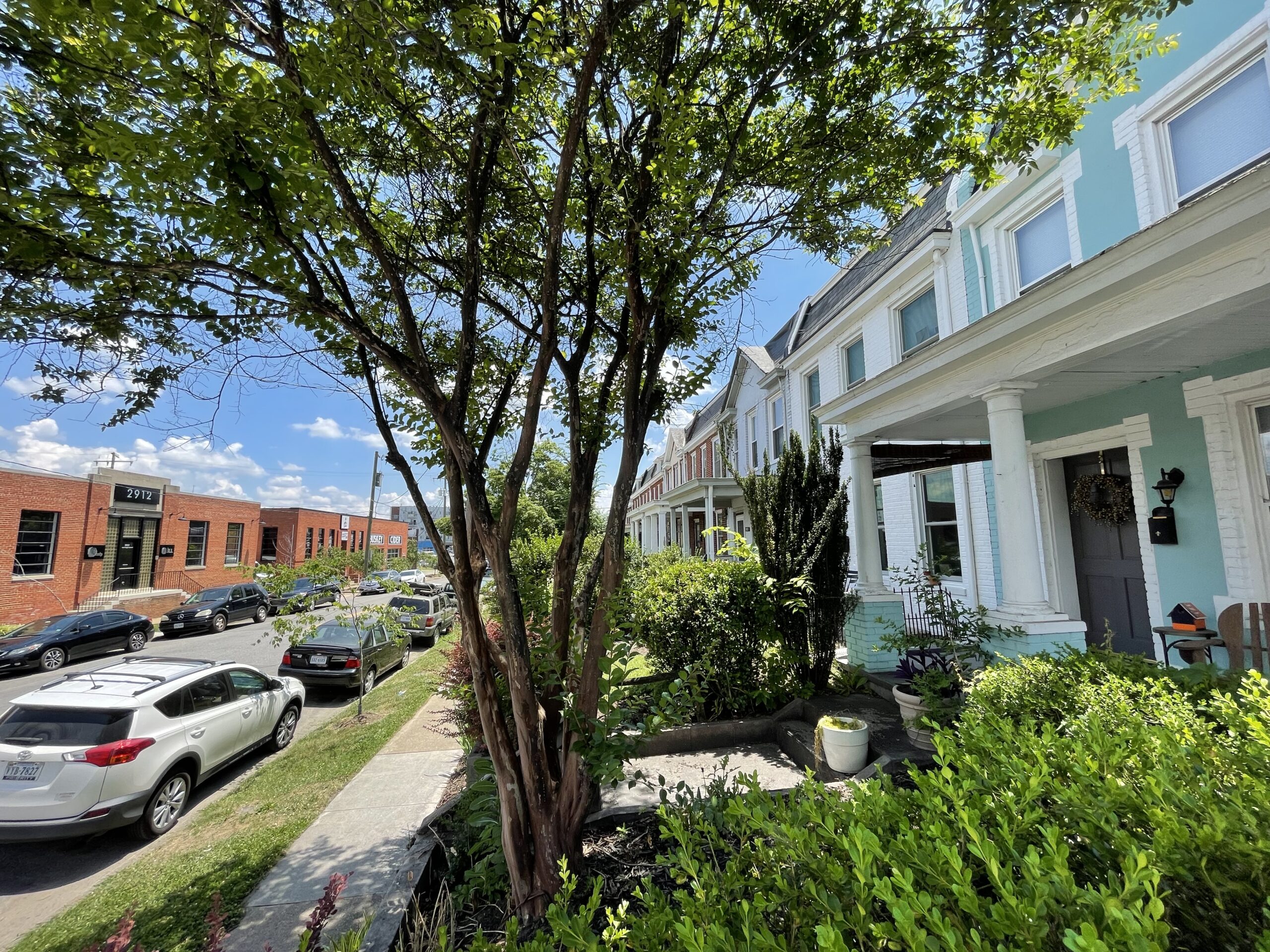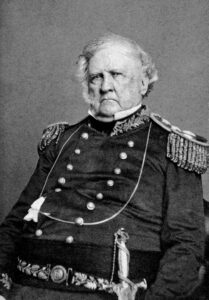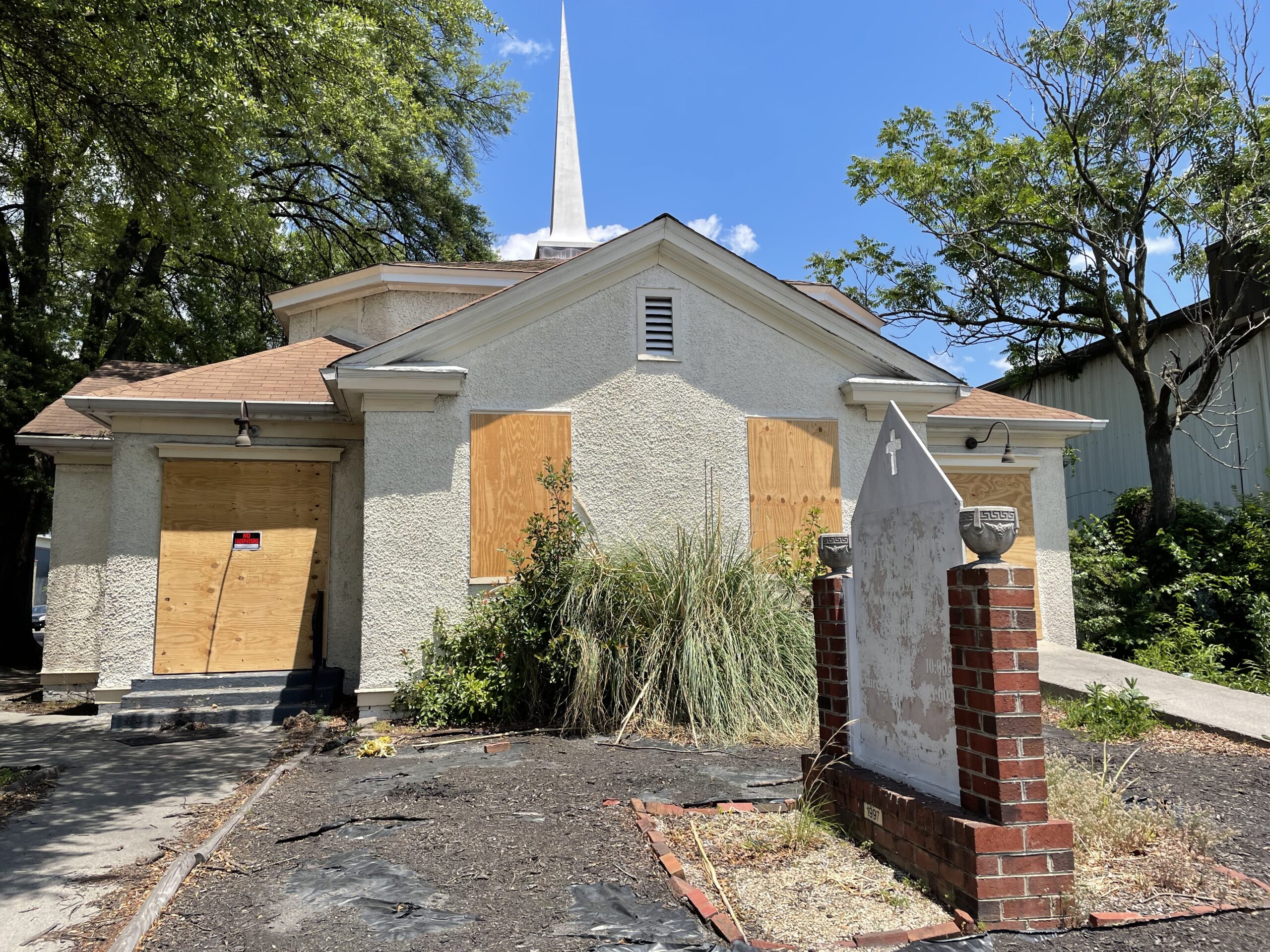
A stretch of the few remaining legacy row houses in the neighborhood sit across from rehabbed old warehouses. (Michael Schwartz photos)
There’s a half-hour wait on Mother’s Day at Lunch.Supper!, the high-casual restaurant in Scott’s Addition. What to do in the meantime? Phyllis Beasley Williams, 91 and stylish in a navy blue and white polka dot outfit, slips onto a bar stool effortlessly while her two daughters and their husbands order vodka martinis all around. “Do you believe this?” asks Williams incredulously but approvingly while surveying the scene, “Scott’s Addition used to be kind of seedy.”
Clearly, the rapidly evolving neighborhood of eateries, breweries, offices and apartment complexes is not your grandmother’s Scott’s Addition.
From the late 1930s, when Williams was growing up at her family’s Dorey dairy farm operation in eastern Henrico Country, to more recently since she has lived in Westhampton, there was little reason for her, like many locals, to venture into the diamond-shaped, mixed-use neighborhood. It is bounded by West Broad, Arthur Ashe Boulevard, I-195, and the Richmond Fredericksburg & Potomac train yards. The tight street grid once contained rows of modest, one- and two-story houses and duplexes with coal-burning stoves and outdoor toilets.
“By the 1940s most residents who lived in the city’s core were simply too poor to get out,” according to Richmond historian Christopher Silver. Interspersed with the dwellings were unrelenting warehouses and industrial buildings. Carter’s Brothers Trucking, Binswanger Glass, Mercer Rug Cleaning, Baker’s Diaper Service and the Coca Cola bottling plant were signature operations.
Back in the day there were also two grocery stores and numerous places to grab lunch or a treat — Thurston’s Sandwich Shop, Arnette’s Ice Cream, Shadwell Drug and Curles Neck Dairy Bar. Just across the street from the Addition was Bill’s Barbecue. The Summit Avenue building where Phyllis Williams and her family enjoyed Mother’s Day had previously housed eateries, Butcher’s Bar and Grill and, more recently, Sue’s Country Kitchen. Today, spanking new mid-rise apartment buildings are sprouting up with aspirational names like the Icon, the Preserve and the Summit.
Try to imagine Scott’s Addition as flat farmlands. Two hundred years ago it was part of Bellville, an 800-acre estate owned by John Mayo, a Richmond engineer (his father had built the original Mayo Bridge that linked Richmond and Manchester). Much of the farm acreage became part of the dowry of John Mayo’s daughter, Maria, when in 1817 she married Winfield Scott, a Dinwiddie County native and up-and-coming soldier (he ran for president in 1852, losing to Franklin Pierce). Serving all the presidents from Jefferson to Lincoln, he was a general in the War of 1812 and the Mexican War. During the Civil War he led the Union forces. The Scotts later settled in upstate New York and never farmed their Henrico County property. The couple’s seven children inherited Bellville and in the late 19th century the City of Richmond acquired the land for residential development. It extended the street grid — Marshall, Clay, Leigh and Moore streets — westward as Scott’s Addition. In 1919, when the Broad Street Station (now the Science Museum of Virginia) was built and rail yards were extended westward, new warehouse construction stifled residential growth. After 1921, when the Addition was zoned for industrial use, residents of the all-white, blue-collar neighborhood doubled down and dug in for the long haul.
“We had our own leaders, our own rules and our own social system,” wrote former resident Ken Woodcock of the neighborhood from the 1930s to the 1950s in a published and unsparing memoir. Sadly, he described the de facto ban on black persons being in the neighborhood at night. Small vigilantes of black-hooded men patrolled the dark streets and alleys with baseball bats. According to Woodcock, one victim was a well-liked teenager who lived in Carver and worked in concessions at Moore’s Field. The city’s 10,000-seat then-semi-professional baseball park was located at the northern tip of the diamond hard against the railyard. He couldn’t leave his job at the ballpark until he had cleaned up after night games.
White boys in Scott’s Addition, meanwhile, regularly sneaked into Moore’s Field to play baseball late at night. Some blocks away a half-court basketball court was set up behind Roseneath Presbyterian, one of two congregations in the Addition. Football was played in a lot near the old Boulevard Baptist Church at 2944 W. Marshall St. More raucously, until the 1940s, local youngsters occasionally left their turf to battle boy gangs across town in Oregon Hill and Church Hill. Apparently, Scott’s Addition boys were hard-wired to get in the first lick.
The tight-knit neighborhood’s boys and girls attended public schools at Robert E. Lee Elementary (now condominiums) in the Museum District, Binford in the Fan District for junior high, and Thomas Jefferson High in the West End. Weekdays, as some 800 workers descended on the neighborhood for jobs, many residents of the Addition had jobs in South Richmond at DuPont and various tobacco operations. An annual highlight all residents enjoyed was a regional event for which they had front row seats. The Grand Illuminated Parade of the National Tobacco Festival (held from 1948 to 1984) made its way from West Broad and onto the Boulevard. Popular features were high-stepping bands and elaborate floats or convertibles that ferried beauty queens from the tobacco belt communities of Southside Virginia and North Carolina. Frank Sinatra once served as parade grand marshal.
If the tobacco festival eventually disappeared because of the product it promoted, so did other local attractions. Scott’s Addition once had a red-light district in the 1000 and 1100 blocks of North Sheppard Street. Bootleggers and brothels occupied the houses and apartments along the stretch. Since street cars stopped nearby on Broad Street, traffic was constant. Today there’s no trace of those buildings; majestic elms arch the street. Who knew?
Editor’s note: This is the first of three installments about Scott’s Addition. The next part will explore the architecture of the neighborhood and the final a critique of new buildings in the district.

A stretch of the few remaining legacy row houses in the neighborhood sit across from rehabbed old warehouses. (Michael Schwartz photos)
There’s a half-hour wait on Mother’s Day at Lunch.Supper!, the high-casual restaurant in Scott’s Addition. What to do in the meantime? Phyllis Beasley Williams, 91 and stylish in a navy blue and white polka dot outfit, slips onto a bar stool effortlessly while her two daughters and their husbands order vodka martinis all around. “Do you believe this?” asks Williams incredulously but approvingly while surveying the scene, “Scott’s Addition used to be kind of seedy.”
Clearly, the rapidly evolving neighborhood of eateries, breweries, offices and apartment complexes is not your grandmother’s Scott’s Addition.
From the late 1930s, when Williams was growing up at her family’s Dorey dairy farm operation in eastern Henrico Country, to more recently since she has lived in Westhampton, there was little reason for her, like many locals, to venture into the diamond-shaped, mixed-use neighborhood. It is bounded by West Broad, Arthur Ashe Boulevard, I-195, and the Richmond Fredericksburg & Potomac train yards. The tight street grid once contained rows of modest, one- and two-story houses and duplexes with coal-burning stoves and outdoor toilets.
“By the 1940s most residents who lived in the city’s core were simply too poor to get out,” according to Richmond historian Christopher Silver. Interspersed with the dwellings were unrelenting warehouses and industrial buildings. Carter’s Brothers Trucking, Binswanger Glass, Mercer Rug Cleaning, Baker’s Diaper Service and the Coca Cola bottling plant were signature operations.
Back in the day there were also two grocery stores and numerous places to grab lunch or a treat — Thurston’s Sandwich Shop, Arnette’s Ice Cream, Shadwell Drug and Curles Neck Dairy Bar. Just across the street from the Addition was Bill’s Barbecue. The Summit Avenue building where Phyllis Williams and her family enjoyed Mother’s Day had previously housed eateries, Butcher’s Bar and Grill and, more recently, Sue’s Country Kitchen. Today, spanking new mid-rise apartment buildings are sprouting up with aspirational names like the Icon, the Preserve and the Summit.
Try to imagine Scott’s Addition as flat farmlands. Two hundred years ago it was part of Bellville, an 800-acre estate owned by John Mayo, a Richmond engineer (his father had built the original Mayo Bridge that linked Richmond and Manchester). Much of the farm acreage became part of the dowry of John Mayo’s daughter, Maria, when in 1817 she married Winfield Scott, a Dinwiddie County native and up-and-coming soldier (he ran for president in 1852, losing to Franklin Pierce). Serving all the presidents from Jefferson to Lincoln, he was a general in the War of 1812 and the Mexican War. During the Civil War he led the Union forces. The Scotts later settled in upstate New York and never farmed their Henrico County property. The couple’s seven children inherited Bellville and in the late 19th century the City of Richmond acquired the land for residential development. It extended the street grid — Marshall, Clay, Leigh and Moore streets — westward as Scott’s Addition. In 1919, when the Broad Street Station (now the Science Museum of Virginia) was built and rail yards were extended westward, new warehouse construction stifled residential growth. After 1921, when the Addition was zoned for industrial use, residents of the all-white, blue-collar neighborhood doubled down and dug in for the long haul.
“We had our own leaders, our own rules and our own social system,” wrote former resident Ken Woodcock of the neighborhood from the 1930s to the 1950s in a published and unsparing memoir. Sadly, he described the de facto ban on black persons being in the neighborhood at night. Small vigilantes of black-hooded men patrolled the dark streets and alleys with baseball bats. According to Woodcock, one victim was a well-liked teenager who lived in Carver and worked in concessions at Moore’s Field. The city’s 10,000-seat then-semi-professional baseball park was located at the northern tip of the diamond hard against the railyard. He couldn’t leave his job at the ballpark until he had cleaned up after night games.
White boys in Scott’s Addition, meanwhile, regularly sneaked into Moore’s Field to play baseball late at night. Some blocks away a half-court basketball court was set up behind Roseneath Presbyterian, one of two congregations in the Addition. Football was played in a lot near the old Boulevard Baptist Church at 2944 W. Marshall St. More raucously, until the 1940s, local youngsters occasionally left their turf to battle boy gangs across town in Oregon Hill and Church Hill. Apparently, Scott’s Addition boys were hard-wired to get in the first lick.
The tight-knit neighborhood’s boys and girls attended public schools at Robert E. Lee Elementary (now condominiums) in the Museum District, Binford in the Fan District for junior high, and Thomas Jefferson High in the West End. Weekdays, as some 800 workers descended on the neighborhood for jobs, many residents of the Addition had jobs in South Richmond at DuPont and various tobacco operations. An annual highlight all residents enjoyed was a regional event for which they had front row seats. The Grand Illuminated Parade of the National Tobacco Festival (held from 1948 to 1984) made its way from West Broad and onto the Boulevard. Popular features were high-stepping bands and elaborate floats or convertibles that ferried beauty queens from the tobacco belt communities of Southside Virginia and North Carolina. Frank Sinatra once served as parade grand marshal.
If the tobacco festival eventually disappeared because of the product it promoted, so did other local attractions. Scott’s Addition once had a red-light district in the 1000 and 1100 blocks of North Sheppard Street. Bootleggers and brothels occupied the houses and apartments along the stretch. Since street cars stopped nearby on Broad Street, traffic was constant. Today there’s no trace of those buildings; majestic elms arch the street. Who knew?
Editor’s note: This is the first of three installments about Scott’s Addition. The next part will explore the architecture of the neighborhood and the final a critique of new buildings in the district.


Another outstanding article from Professor Slipek. I love it when he details the history and the little-known stories of various Richmond neighborhoods, people, places, etc. I have a personal connection to Scott’s Addition: my father worked for — and later managed — an envelope printing company in the 3400 block of W. Leigh Street in Scott’s from the time he returned from fighting in Europe in WWII in 1946 until he retired around 1990. He took over management of the company in 1970. Since my mother went to work for the company in the summers when school was out of… Read more »
Bravo, Professor Slipek! I am looking forward to the next two installments.
A minor typo: the name of the baseball park was Mooers Field, named for owner, former player, and former manager Eddie Mooers, who went on to own a car dealership (which was Mooers Volvo until recently).
After it’s life as a ballpark (succeeded in that role by Parker Field in the 1950s) Mooers Field became a auto racetrack. Until recently it served as a brickyard for Riverside Brick until being sold last year to an apartment developer.
This is the content I crave.
Look forward to that “critique of new buildings in the district”.